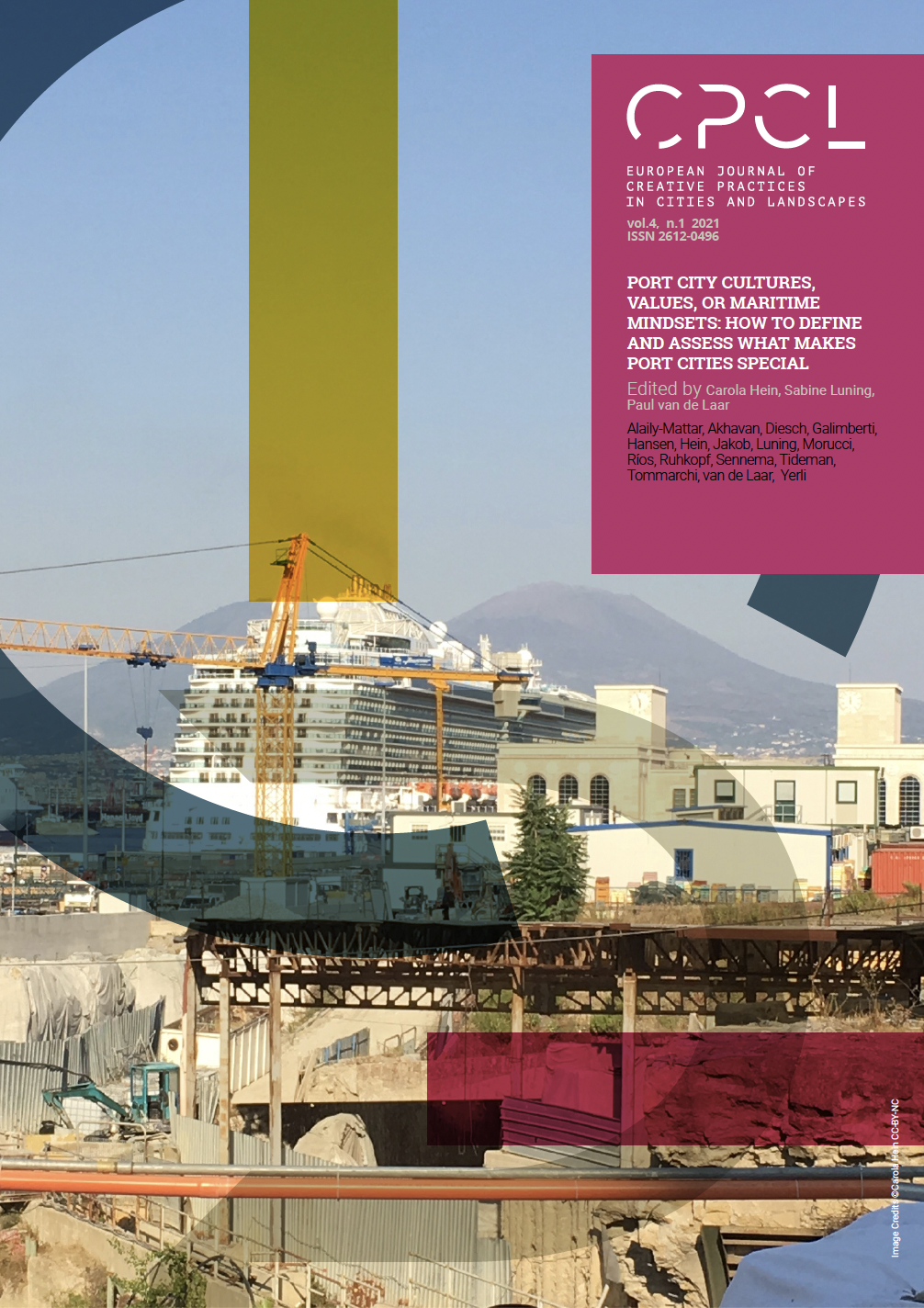Rotterdam’s New Waterway: The Iconification of an Infrastructure (1860-1947)
DOI:
https://doi.org/10.6092/issn.2612-0496/12389Keywords:
Infrastructure, Culture, Port Cities, Urban Iconography, Port CultureAbstract
Rotterdam is not just a port city defined by its significance as a transit, petroleum or container port, but also by the heterogenic images and narratives that surround it. In this paper, we use images of the New Waterway – a nationally engineered infrastructure – to analyze its process becoming an icon of the globalized progress that made the port city of Rotterdam the leading port of the European continent at the beginning of the twentieth century. In order to better understand why and how the New Waterway was used as such an icon, we analyze the discourse that was represented in works of art during three phases: a monument for the Waterway’s instigator and engineer Caland in 1906, a diorama of the Waterway for the World Expo in 1931, and two theatrical plays during the Second World War and reconstruction of the port city (1941, 1947). We find that these iconic works appropriated the national plan of a new waterway between the North Sea and the hinterland, to an urban narrative that represented values of modern Rotterdam: resoluteness, progress, and resilience in times of hardship.
References
Backx, Johannes Philippus. “Commercieel havenbeheer.” In Beschouwingen over de haven van Rotterdam : zes lezingen gehouden voor het Departement Rotterdam van de Nederlandsche Maatschappij voor Nijverheid en Handel in den winter 1931-1932, 23–50. Rotterdam: Nijgh & Van Ditmar, 1932.
———. De haven van Rotterdam: onderzoek naar de oorzaken van haar economische betekenis in vergelijking met Hamburg en Antwerpen. Rotterdam: Nijgh & Van Ditmar, 1929.
Besselaar, Herman. “De weg naar zee.” Stadsarchief Rotterdam, 1941. “De Wereldtentoonstelling Te Antwerpen. De Deelneming van Rotterdam.” Tilburgsche Courant, November 25, 1929.
Droogendijk, Jan Marie. Van visschersdorp tot wereldstad : het 600-jarig bestaan der stad Rotterdam herdacht. Rotterdam: J.M. Bredée’s U.M, 1928.
Engelbrecht, Willem Anton. “Het ontstaan van den Hoek van Holland.” In Rotterdams Jaarboekje, 2:55–64. 4. Rotterdam: W.L. & J. Brusse, 1934.
———. Rede ter gelegenheid van den aanvang van het werk. Rotterdam: Kamer van Koophandel en Fabrieken, 1936.
Hein, Carola. “The Port Cityscape: Spatial and Institutional Approaches to Port City Relationships.” PORTUSplus 8 (2019). https://portusplus.org/index.php/pp/article/view/190.
Hodos, Jerome I. Second Cities: Globalization and Local Politics in Manchester and Philadelphia. Philadelphia: Temple University Press, 2011.
Hudig, Jan. “In memoriam L. Pincoffs.” In Rotterdamsch Jaarboekje, 10:175–85. 1. Rotterdam: P.M. Bazendijk, 1912.
Hulme, Tom. “‘A Nation of Town Criers’: Civic Publicity and Historical Pageantry in Inter-War Britain.” Urban History 44, no. 2 (2017): 270–92. https://doi.org/10.1017/S0963926816000262.
“Installatie van Mr. A.R. Zimmerman als burgemeester van Rotterdam.” Algemeen Handelsblad, May 2, 1906.
Kaika, Maria. “Autistic Architecture: The Fall of the Icon and the Rise of the Serial Object of Architecture.” Environment and Planning D: Society and Space 29, no. 6 (December 2011): 968–92. https://doi.org/10.1068/d16110.
Klerk, Len de. Frédéric en Antoine Plate 1802-1927: Rotterdamse kooplieden, reders en bestuurders. Hilversum: Uitgeverij Verloren BV, 2019.
Konvitz, Josef. “Contemporary Urban History: What the Study of Port Cities Implies for Evidence, Methodology, and Conceptualization.” Journal of Urban History 39, no. 4 (2013): 801–6. https://doi.org/10.1177/0096144212470248.
Kowalewski, Maciej. “Images and Spaces of Port Cities in Transition.” Space and Culture 24, no. 1 (2018): 53–65. https://doi.org/10.1177/1206331218783940.
Laar, Paul van de. Coolsingel: 700 jaar Rotterdammers en hun stad. Amsterdam: Bas Lubberhuizen, 2017.
———. Stad van formaat: geschiedenis van Rotterdam in de negentiende en twintigste eeuw. Zwolle: Waanders, 2000.
Laar, Paul van de, and Kim Zweerink. “De randstad: een vreemde metropool.” Holland : historisch tijdschrift, no. 3 (2009): 187–206.
Lee, Robert. “The Socio-Economic and Demographic Characteristics of Port Cities: A Typology for Comparative Analysis?” Urban History 25, no. 2 (August 1998): 147–72. https://doi.org/10.1017/S096392680000078X.
Middell, Matthias, and Katja Naumann. “Global History and the Spatial Turn: From the Impact of Area Studies to the Study of Critical Junctures of Globalization.” Journal of Global History 5, no. 1 (March 2010): 149–70. https://doi.org/10.1017/S1740022809990362.
“Overzicht van de ontwikkeling van de nieuwe waterweg 1858-1958.” Stadsarchief Rotterdam, 1958. Ringers, Johan. Caland en de betekenis van zijn werk voor Rotterdam. Rotterdam: Ad. Donker, 1953. https://repository.tudelft.nl/islandora/object/uuid%3A5afd7e94-73eb-4046-8e94-41f0e2ce3e67.
Schubert, Dirk. “Ports and Urban Waterfronts.” In The Routledge Handbook of Planning History, edited by Carola Hein, 338–49. New York: Routledge, 2018.
Sennema, Hilde. “Voor stad en haven : Jan Backx en de wederopbouw van Rotterdam.” In Rotterdams Jaarboekje, 248–71. Rotterdam: Historische Publicaties Roterodamum, 2016.
Taylor, Charles. “Modern Social Imaginaries.” Public Culture 14, no. 1 (January 2002): 91–124. https://doi.org/10.1215/08992363-14-1-91.
Woud, Auke van der. Een nieuwe wereld: het ontstaan van het moderne Nederland. Amsterdam: B. Bakker, 2006.
Downloads
Published
How to Cite
Issue
Section
License
Copyright (c) 2021 Hilde Sennema, Paul Th. Van de Laar

This work is licensed under a Creative Commons Attribution 4.0 International License.




